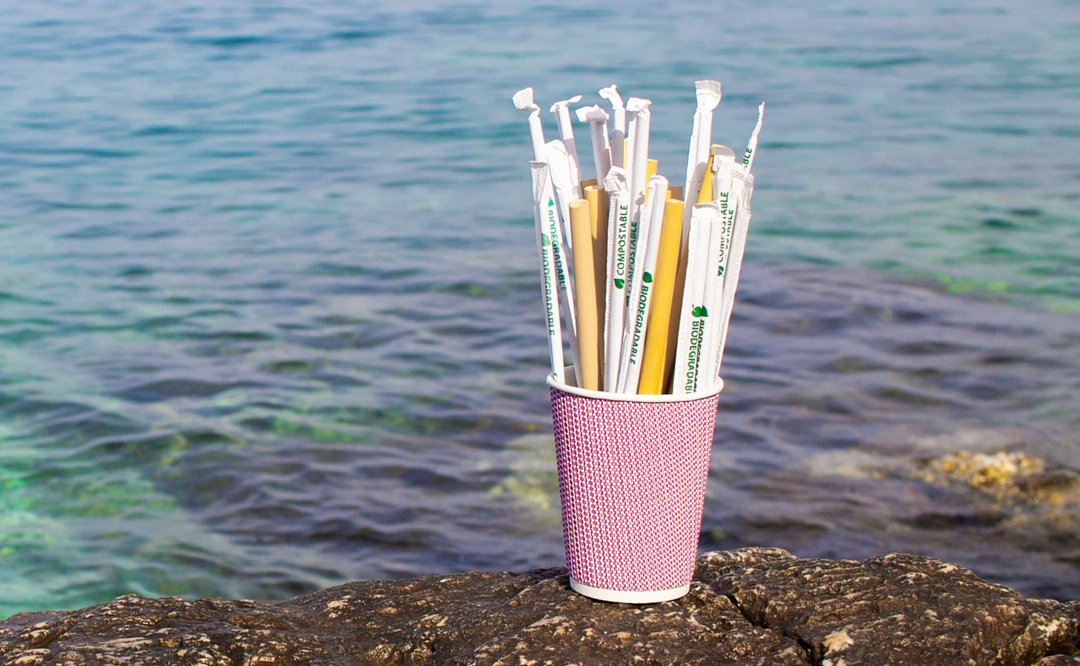SOLVING THE PLASTIC PROBLEM
Bioplastics are being touted as the solution to the planet’s growing plastic pollution problem. With companies like Pepsi, Nestle, Coca-Cola, and other big-name beverage corporations shifting their plastic packaging to bioplastics aka “plant plastics,” we wanted to learn more about how bioplastics are created and uncover if they are actually better for the planet.
Bioplastics have been around since the mid-1800s when inventor Alexander Parkes created a plastic polymer out of chloroform and castor oil. Since then, numerous types of bioplastics have been created out of a variety of plant and animal matter. Bioplastics are defined as a type of biodegradable plastic derived from biological substances. Traditional plastics are made from petroleum-based raw materials. Bioplastics are currently used in numerous products like packaging, containers, bottles, bags, and straws.
There are two main types of bioplastics, PLA (polylactic acid) and PHA (polyhydroxyalkanoate). PLA is made from sugars sourced from sugarcane, corn, or cassava biowaste. It is biodegradable, carbon-neutral, and edible. PHA is made by microorganisms. These microbes are given carbon but are deprived of nutrients like nitrogen, oxygen, and phosphorus, thus producing PHA from its excess carbon reserves. PHA is biodegradable and is commonly used in the medical industry as well as single-use food packaging.
While bioplastics are often considered to be more sustainable, many studies have found that it might not necessarily be the case. One of the biggest issues with the production of bioplastics is the pollution levels that come from growing the crops, water and pesticide usage, as well as the chemical processing that takes place to turn crops into plastic. Another issue is the amount of land needed to produce crops for bioplastics competes with land needed to grow food. One study also found that bioplastics contributed to more ozone depletion than traditional plastics.
On the contrary, it has been shown that bioplastics’ greenhouse gas emissions are significantly less and traditional plastics over their lifetime. Once the bioplastics have been created there is not a net increase in carbon dioxide because the plants they are made from absorbed equal amounts of CO2 in the growing process.
Currently, the biggest hurdle for bioplastics is their recycling potential. Very few cities have the infrastructure needed to recycle bioplastics and if not discarded properly, they can contaminate batches of traditional recycled plastics. Separate recycling streams are needed to properly recycle bioplastics. To combat this problem, some companies are using a mixture of bioplastics and recycled plastic so it can be recycled in most curbside programs.
The concept that bioplastics are better for the environment just because it is sourced from a plant can be misleading and can usher consumers into believing that bioplastics can be disposed of in any way. The majority of bioplastics currently produced are ending up in landfills.
While we love to see the innovation taking place in the field of bioplastics in the hopes to reduce our plastic pollution crisis, its production is currently in its infancy and needs much more sustainable innovation in regards to all aspects of its life cycle. Instead, might we consider globally reducing our overall plastic production and consumption, as well as recycling at far greater rates than the dismal 9% that is currently taking place?
The plastic pollution issue doesn’t come down to the next great bioplastic innovation, it comes down to humanity taking responsibility for the crisis we have each individually created through our daily choices. Marine and wildlife all over the planet are paying the price for our lack of care and privilege as a species.
Substantial commitments to improving the plastic pollution problem must come from all citizens of our planet, businesses, and governments collectively to solve this global crisis. Individually, we can vow to reduce our plastic consumption, support sustainable companies that are producing products without plastic packaging, and recycle all recyclable plastics we consume.
It’s up to each of us to utilize our #100 Power of Choice. See all 100 Ways to Heal The Planet and start to co-create the kind of planet you would like to see.
If this resonates with you please TAKE ACTION NOW and share this with as many others as you can.
#HealThePlanet
#100WaysToHealThePlanet
#TheConsciousBuyer
#BioPlastics
#ChooseLove
#SpreadLight
#SpreadLove
#Gratitude

